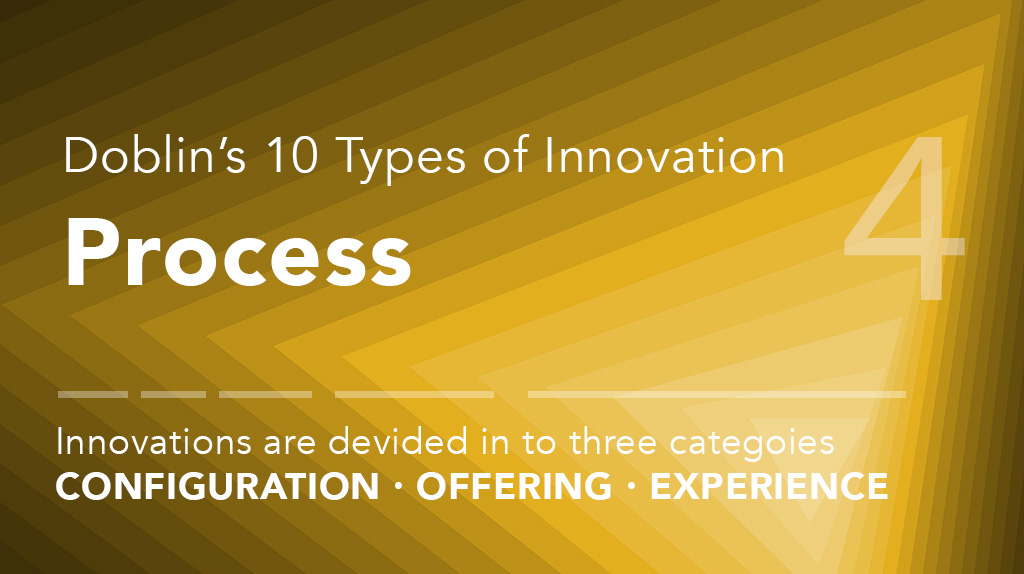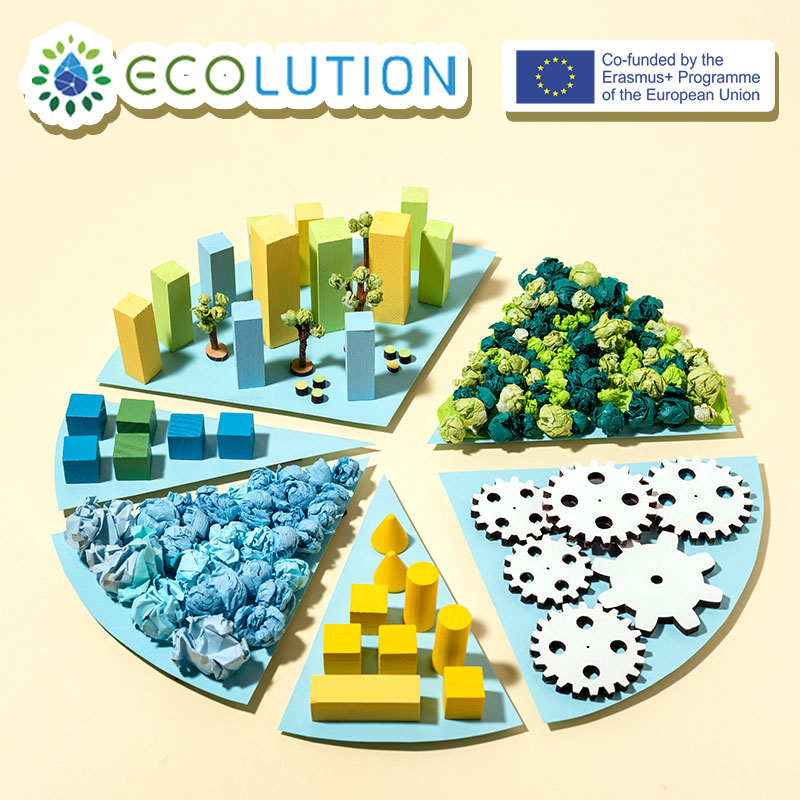Intro
In this series of posts, we will be inspecting Doblin’s 10 Types of Innovation, a popular framework for analyzing innovations in business developed by the Doblin Innovation Firm in Chicago. Innovations are divided into three categories: configuration, offering, and experience. Configuration focuses on the innermost workings of an enterprise and its business system, offering focuses on an enterprise’s core product or service, and experience focuses on customer-facing elements. In this post, we will analyze the fourth block in configuration, process innovation.
Definition
Process Innovation is essentially about how you use your signature or superior methods to do your work. Doblin defines process innovation as:
“Process innovations involve the activities and operations that produce an enterprise’s primary offerings. Innovating here requires a dramatic change from “business as usual” that enables the company to use unique capabilities, function efficiently, adapt quickly, and build market–leading margins. Process innovations often form the core competency of an enterprise and may include patented or proprietary approaches that yield advantage for years or even decades. Ideally, they are the “special sauce” you use that competitors simply can’t replicate.”
Process innovations are similar to structure innovations in that both have to do with rethinking the way things work inside a company. Process innovations enable companies to improve its core competencies (products or services) in a more time or cost-efficient manner than their competitors or in ways that are more accessible or appealing to customers. The efficiency improvement of processes reduce production time and costs, and represents the essence of how a company does its business.
Examples
Process innovations have been around for hundreds of years in various forms, whether it’s a patented approach, breakthrough methodology, or improvements in the chain supply and logistics processes. Here are some common types of process innovations according to Larry Keeley:
- Crowdsourcing – outsource tasks and cast a wide call for others to complete them.
- Flexible Manufacturing – set up manufacturing processes that can be easily changed, customized, or redirected.
- Lean Production – dramatically eliminate the waste and associated costs through everyday processes.
- On-Demand Production – Set up purchasing and fulfillment systems such that products are only produced when ordered.
- Process Standardization – uses common procedures to reduce cost and complexity
- Predictive Analytics – using past performance data to predict future outcomes
For this blog post, we will first introduce historical examples of process innovations, and then focus on companies that have streamlined their production and processes as well as those that are implementing on-demand production.
Historical Examples
These process innovations were the first of their kind and largely impacted innovation and inventing all over the world.
The cotton gin was invented in 1794 by U.S.-born inventor Eli Whitney, who would later go on to develop standardized, interchangeable parts for manufactured products. The cotton gin greatly sped up the process of removing seeds from cotton fiber, a task that until then was time and labor intensive since it had to be done by hand. The machine revolutionized the cotton industry and transformed the U.S. economy — by the mid-19th century, cotton was America’s leading export.

The Ford Motor Company is an American multinational automaker founded in 1903 by Henry Ford. Henry Ford pioneered the assembly line for automobile manufacturing, which previously required highly trained and knowledgeable workers who would put together cars piece by piece. As a result of the assembly line, workers required far less training as they only needed to master a single task, and the increase in efficiency dramatically reduced costs and made it feasible for average Americans to afford an automobile.

McDonald’s
McDonald’s is an American fast-food company founded in 1940 by the McDonald brothers. McDonald’s is famous for their process innovations, starting with their adoption of an assembly line in their kitchens to quickly and efficiently fill customer’s orders. One of McDonald’s more recent process innovations is a central call center that takes drive-thru orders from several restaurants at once, saving them a few seconds per order.

Lean Production
These companies have found innovative ways to streamline production and processes in their value chains.
Google is an American multinational technology company that specializes in Internet-related services and products. Their 20% Project allows employees to spend 20% of their time working on personal projects that could be beneficial to the company. These types of initiatives are widespread in Silicon Valley, and many argue that they lead to more productive and satisfied employees.

Zipcar
Zipcar is an American car-sharing company and a subsidiary of Avis Budget Group. Zipcar brought innovation to the stagnant car rental industry by nixing complex infrastructure, longlines, unnecessary paperwork, add-on fees, and customer-facing employees by focusing on cars, parking spots, and a streamlined, automated process. By emphasizing short, hassle-free rentals, Zipcar was able to dramatically improve the rental experience for their customers while freeing up management to focus on demand statistics and inventory.

IKEA is a Swedish multinational conglomerate that designs and sells ready-to-assemble furniture, kitchen appliances, and home accessories. IKEA’s entire business model revolves around standardized “flat-pack” furniture and instructions, which streamlined their internal production processes. As a result, IKEA is able to sell their furniture at a much lower cost than many of their competitors.

The Tata Group is an Indian multinational conglomerate founded in 1868 comprising of 30 companies across ten verticals. Their Computational Research Laboratories (CRL) is continuously experimenting with ways to maximize computing efficiency, as seen in their development of a parallel processing library technology. As a result, the CRL was able to build the fourth fastest computer in the world in 2007, capable of performing 117.9 trillion floating operations per second.

On-demand Production
These companies have found ways to adapt to flexible and rapid-changing demand in order to better serve customers and secure more profits.
Zara is a Spanish apparel retailer specializing in fast fashion and the largest company in the Inditex group. While fashion was traditionally slow moving and driven by seasons and ramps, Zara helped pioneer fast fashion, which used supply chain optimization in order to deliver fashion trends from runways and sketches to shop floors in just three weeks. As a result, Zara has become one of the most prominent fashion retail companies and fast fashion has revolutionized the industry.

Walmart is an American multinational retail corporation that operates a chain of hypermarkets, discount department stores, and grocery stores. Walmart has adopted the use of real-time inventory management systems as well as aggressive volume/price/delivery contracts with its suppliers in order to allow store management to respond quickly to shopper behavior. As a result, Walmart is able to maintain their competitive prices as well as reduce the load on their supply chain.

Vortic is a small-batch custom watch manufacturing and vintage restoration company that upcycles vintage pocket watch movements into Corning Gorilla Glass-faced watches. They developed this process by first creating a proprietary case design and fit process for each watch, which is then individually 3D printed and machined. This on-demand production of watches helps maintain the high profit margins of luxury goods while also savings production-related costs by eliminating excess.

Techniques to Develop Process Innovation
Process innovation is inherently rooted in improving the core competency of a company by changing the activities and operations that go into creating that competency. This can be done in a number of ways. First, inspect every step of the process, including manufacturing and development processes and fixed costs. Are there ways to improve efficiency? Is there a new technological breakthrough that, if implemented, will put your offering a notch above your competitors? Are there any redundant steps that waste time?
While many companies rely on their IT organizations for process innovations through computing and automation implementations, large investments in IT systems aren’t always the answer if companies are simply using computers to speed up existing methods and processes when they should be redesigning them from scratch. The Harvard Business Review also argues that employees themselves are a great source of process innovation ideas — after all, they are the ones who are most intimately familiar with the processes in the first place. The people of a company are an important aspect of all processes that shouldn’t be overlooked, as employees can often feel victimized by sudden changes that require retraining and radically altered routines. Taking them and their concerns into consideration will undoubtedly smooth over the innovation process.
All process innovations have one of four aims: to decrease production or delivery costs, to reduce the cost per produced product, to increase the number of products produced, or to increase the quality or efficiency of a process. All process innovations also must include a methodology or capability that is significantly different from and superior to industry norms. What may have been an innovation in the past is no longer considered so if every competitor in the market adopts it unless one company is able to deliver unmatched efficiency and cost advantage.
At the same time, managers must consider process innovation carefully. Process innovation that does not expressly target competitive advantage may be wasted time and effort. In addition, not all processes need to be continually assessed and improved, and a mindset that is obsessive on process innovation in any aspect may lead to improving the wrong activities while ignoring the important ones.
Further, a company’s need for process innovation depends on its size and offering. As stated in the Harvard Business Review, companies that compete by providing customers with consistent, reliable, and low-cost products and services like Walmart, FedEx, and McDonald’s have a need to continuously improve all of their operational processes. However, startups that are rushing to get their product or service to market don’t need to be concerned with process innovation, and neither do companies with breakthrough products like patented drugs, as they have a much wider margin of error due to the uniqueness of their offering. Companies that are incumbent industry leaders, like Google, Apple, and Nike, may not need to focus on perfecting every step of the process, only on offering the latest and greatest products. Ultimately, it is critical that management uses all of their resources to figure out which processes to improve and when.
Impact
Process innovations can have huge impacts on a company’s bottom line by reducing manufacturing and fixed costs, which allows firms to capture more profit. Improving processes can also greatly improve employees’ quality of life and general morale. In the 21st century, competition between companies is fiercer than ever before, and many companies have access to and can afford top of the line technological equipment. Precisely because of this, it is in companies’ best interests to continually improve and innovate upon their processes, and to key in on what makes them different rather than how they can follow the crowd.
Conclusion
To stay competitive, companies should continually find opportunities for innovation in all of their processes, from customer service and product development to manufacturing and inventory management. Companies that neglect their processes will find themselves stagnating, with inefficient teams, apathetic employees, and revenue streams drying up. Process innovation challenges companies to think of ideas that are out of the box and bring out what is unique about a company and its offering. As we’ve seen throughout history, the best process innovations can impact not only companies and industries, but the world.




